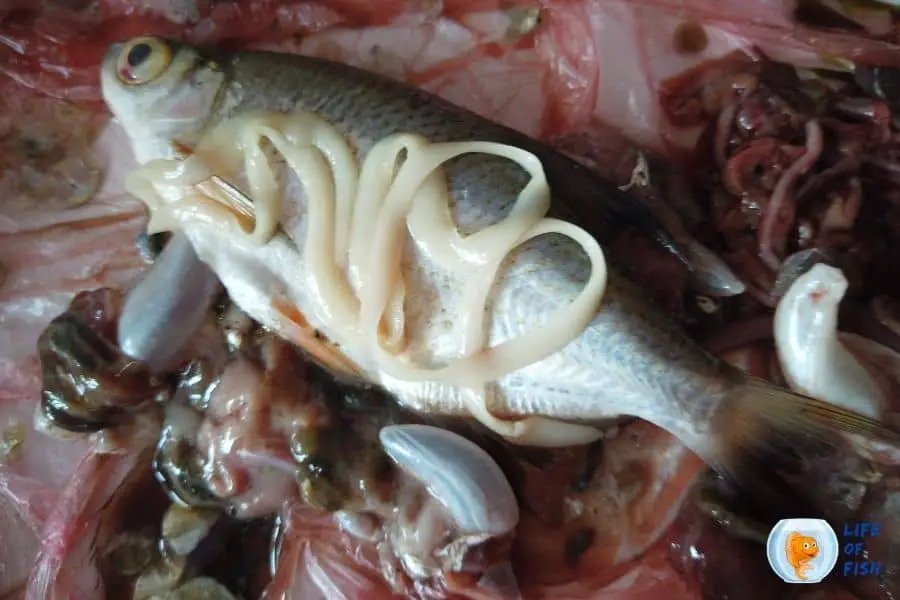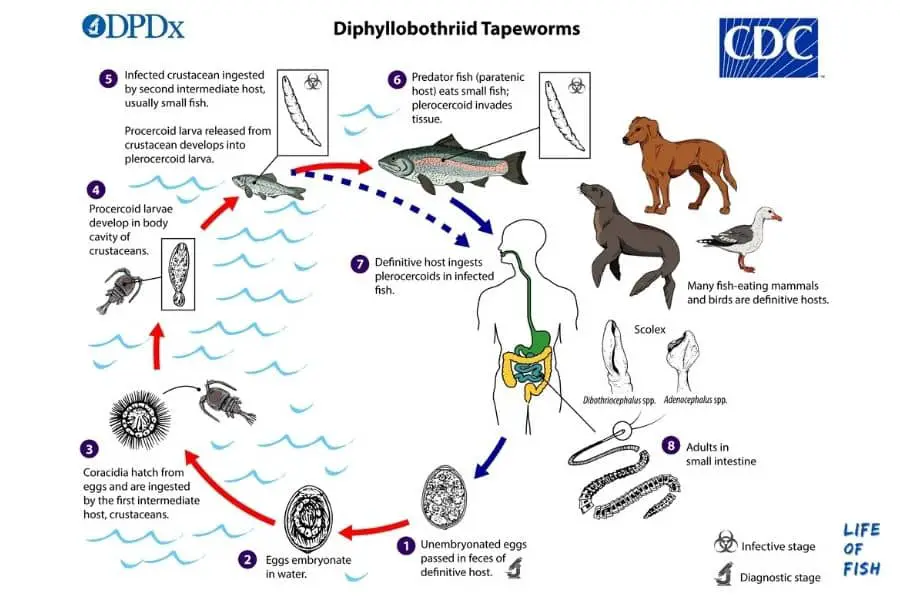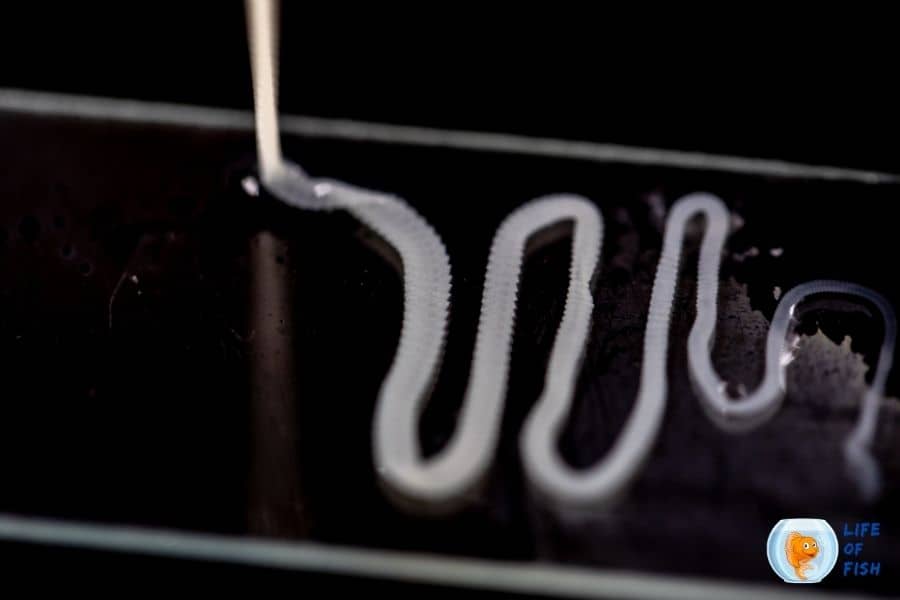Tapeworms are parasitic worms that bother both fish and mammals, including humans. They cause digestive system disorders and eventually death.
Tapeworms are a nuisance for aquarists because they cause serious health problems in fish. Hence, many fish keepers continuously treat their fish to tapeworms.
You can use medicines to get rid of tapeworms in fish tanks, and we are going to explain how to get rid of tapeworms in the fish tank in this article.

What Are Tapeworms?
Jump To
Tapeworms (Diphyllobothrium latum) are internal parasites that affect a wide variety of fish species, including carp and other aquarium fish such as discus.
Although there are different types of tapeworms they all have the same ultimate effect on fish. They cause digestive problems which eventually lead to blockages.
Tapeworms have an aquatic lifecycle. When humans consume infected fish, the humans get infected by Diphyllobothriasis latum.
After ingestion these parasites reproduce inside the human digestive system; hence D.Latum eggs mix with human feces.
In freshwater, these eggs hatch into free-swimming larvae. Microcrustaceans ingest these larvae and then, fish consume these microcrustaceans and get infected with tapeworms.
When humans catch these infected fish and eat them raw, humans get infected. The same cycle goes with mammals like dogs, cats, bears, etc.

Are Tapeworms Harmful or Useful?
Tapeworms are harmful to both fish and mammals. They cause digestive problems in both species.
In humans, the infection is usually asymptomatic. However, the patient may have mild gastrointestinal symptoms such as abdominal discomfort, diarrhea, and weight loss.
In addition, parasites affect humans in the long term by absorbing dietary vitamin B12. This leads to vitamin B12 deficiency and megaloblastic anemia.
In fish, tapeworm infestation affects digestion. Because of these parasites, fish will get lean due to weight loss and will fail to thrive.
Further, the heavy infection may result in intestinal obstruction or gallbladder disease in fish because of the migration of proglottids.
Hence their general health degrades. The tapeworms are not visible in the host’s body. Therefore, it is difficult to tell about tapeworm infection on fish.
How To Detect Tapeworms In Aquarium Or Fish
The only way to diagnose tapeworms is through a blood test or examining the stools.
Unfortunately, these tests are done only on humans, so there is no way to detect tapeworms in fish.
The most frequent sign of infection is failure to gain any weight, or the fish doesn’t grow up as it supposed to be.
If you see any of the above signs on your fish, its time to start the treatments.
How to Treat Tapeworms in Fish
Water-based parasitic treatments do not work well against tapeworms.
You have to use specific tapeworm medicine to treat your fish. Fluke-Solve is a proven anti-parasitic medicine that works with tapeworms.
In addition, you should remove intermediate hosts such as copepods and small snails while treating your fish.
How To Get Rid Of Tapeworms In Fish Tank
Since diagnosing tapeworm in fish is significantly more challenging, the best way is to get rid of tapeworms in fish tanks is to treat all the fish irrespective of their symptoms.
Getting rid of tapeworms have few steps involved, which we discuss below.
Remove Intermediate Hosts
Most often, tapeworms are introduced to fish tanks by intermediate hosts such as copepods and tiny snails.
These microscopic creatures ingest tapeworm larvae from freshwater and keep them inside their bodies until the worm finds a suitable host.
When fish eats these species, larvae go into the fish’s digestive system and begin to absorb nutritions from the fish to grow up.
So, if your tank has a population of these intermediate hosts, chances are they already have tapeworms in their bodies. So, it is vital to remove all of those species before treating your fish.
Treat Your Fish with Fluke-Solve
Not all parasitic medicine contains effective medicines to get rid of tapeworms.
However, Fluke-Solve by Vetark is good tapeworm medicine you can use to treat tapeworms in your fish tanks.
Fluke-Solve contains praziquantel that is safe to use with fish, biofilters, plants, shrimp, snails as well as frogs.
Use 400mg of Fluke-Solve per 22 gallons of water. Mix the medicine with water in the tank.
Remember to turn of skimmers and any filters that use modern filtering technologies such as carbon derivatives and drum filter technologies while treating.
Repeat the treatment Yearly
To ensure that there is no tapeworm build-up in your fish, repeat the treatment on an annual basis.
This way, your fish can be safe not only from tapeworms but also from skin and gill flukes, eye flukes, and immersion as well.
Keep water conditions Properly and Feed Your Fish Well
Poor water quality and an imbalanced diet may also lead to digestive problems.
So, you may not be able to diagnose the problem correctly if your fish lives in polluted water and have a poor diet.
Therefore, ensure that they get to live in a healthy environment with a balanced diet to avoid confusion.

Check Before Buy Your Fish
The best way to prevent tapeworms in your fish tank is to quarantine any species you bring before introducing them to your fish tank.
Keep any fish and other species in a separate tank for at least 30 days and observe them closely. If they show any tapeworm symptoms, treat them with the parasitic medicine we mentioned above.
Always buy the most healthy-looking fish from your pet store. This will prevent diseases such as tapeworms, ich, and other bacterial infections.
How To Quarantine Before Put Your Fish In Tank
- Keep a separate tank with all the necessary equipment installed and running all the time.
- The size of this tank should change according to the type of fish you wish to keep in your aquarium.
- Most fish types require at least a 20-gallon tank to live healthily, so the quarantine tank should also be at least 20 gallons.
- The quarantine tank should also have a filter, an oxygen pump, and a water heater installed and running.
- When you bring new fish home, you should first put them in this quarantine tank.
- Closely observe their changes for at least a month. Then, do necessary treatments as they show any symptoms.
- Once you are sure that they don’t carry any diseases, you can put your new fish into your display aquarium.
- A quarantine tank is also an aquarium, but just for newly introduced aquatic pets and sick pets.
Related Questions
Are fish tank worms harmful to humans?
Some fish tank worms are harmless to humans. But, some worms, such as roundworms, liver flukes, and tapeworms, are harmful to humans.
Humans are not these parasite’s intended hosts. Instead, they are an accidental host.
Yet, roundworms and tapeworms grow and reproduce inside the human body, causing digestive problems.
Conclusion
Tapeworm is a harmful parasite for both fish and mammals. Diagnosing tapeworms in fish is significantly more challenging as fish do not show any symptoms other than weight loss or stunted growth.
However, this parasite can be deadly to fish in the long run. Hence, treating the fish for tapeworms is important.
You can get rid of tapeworms in the fish tank by limiting access to intermediate hosts and annual tapeworm treatment.
The medicine that is used to treat tapeworms in fish is praziquantel. To prevent tapeworm infections in your fish tank, always quarantine any species you bring before introducing them to your fish tank.
Read Next: Easy Methods To Get Rid of Red Worms (Camallanus / Capillria Worm)
